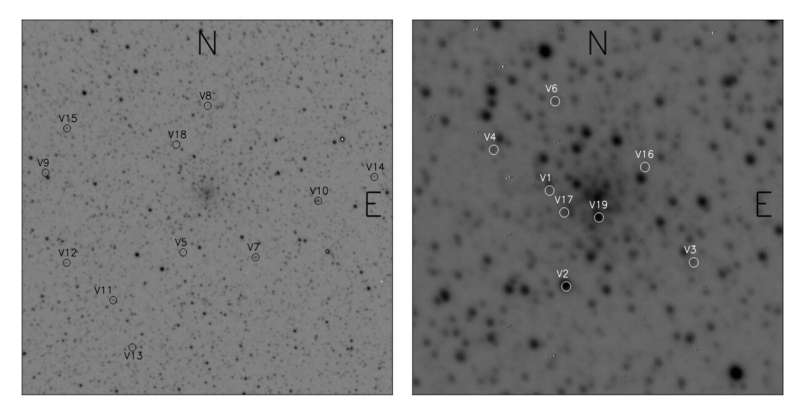July 8, 2024 report
This article has been reviewed according to Science X's editorial process and policies. Editors have highlighted the following attributes while ensuring the content's credibility:
fact-checked
preprint
trusted source
proofread
Two new variable stars detected in globular cluster NGC 6558

An international team of astronomers has conducted a survey of variable stars in the field of a globular cluster known as NGC 6558. As a result, they identified dozens of variables, out of which two turned out to be new cluster members. The finding was reported in a research paper published June 29 on the pre-print server arXiv.
Variable stars could offer important hints into aspects of stellar structure and evolution. They could also be helpful for better understanding the distance scale of the universe. In particular, studies of variable stars in star clusters are of special interest for astronomers as they have the potential to help identify systematic errors that affect stellar distance indicators.
NGC 6558 (also known as GCL 89 or ESO 456-SC62) is a Galactic bulge globular cluster located some 24,100 light years away in the constellation Sagittarius, with an angular size of about 5.4 x 5.4 arcminutes. Previous observations have found that NGC 6558 has a metallicity at a level of -1.32 dex and suggested that it may be one of the oldest objects in the Milky Way.
A group of astronomers led by Armando Arellano Ferro of the National Autonomous University of Mexico, has investigated the stellar content of NGC 6558, hoping to detect new cluster members. For this purpose, they observed the cluster and its surroundings using the National Observatory of Cordoba in Argentina and the Las Campanas Observatory in Chile.
"We made a survey of the variable stars in a 13.2 x 13.2 arcmin2 centered on the field of the Galactic bulge cluster NGC 6558," the scientists wrote in the paper.
All in all, Ferro's team identified 78 variable stars in the field of NGC 6558. Afterward, they conducted proper motion analysis and a thorough exploration of these variables on the color-magnitude diagram (CMD) of the cluster. As a result, it turned out that nine of them are truly members of NGC 6558.
Two out of the nine identified cluster members are new variables, designated V18 and V19. According to the paper, V18 is an eclipsing variable with a period of approximately 0.4 days, while V19 is a semi-regular variable with a period of about 346 days.
By inspecting the member variables, the astronomers managed to calculate the distance to NGC 6558 and the cluster's metallicity. They found that NGC 6558 is located about 27,500 light years away and its metallicity is approximately -1.33 dex.
The researchers also analyzed the sample of RR Lyrae variables of the RRab type in NGC 6558. Based on this, they found that the cluster is most likely of the intermediate Oosterhoff type (Oo-Int). However, further observations are required in order to confirm this assumption.
More information: A. Arellano Ferro et al, The variable stars in the field of the bulge cluster NGC 6558, arXiv (2024). DOI: 10.48550/arxiv.2407.00523
Journal information: arXiv
© 2024 Science X Network




















